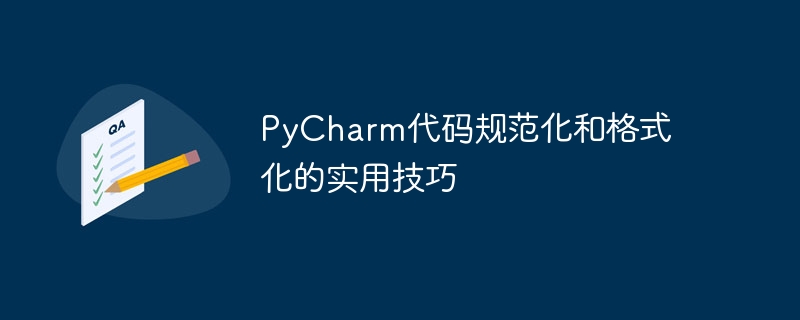

PyCharm is an integrated development environment (IDE) commonly used by Python developers. It provides a wealth of functions and tools to improve code quality and efficiency. Among them, code standardization and formatting is one of the important steps in writing high-quality code. This article will introduce some practical techniques and functions in PyCharm to help developers standardize and format Python code.
PEP8 is the code specification guide officially provided by Python, which contains a series of suggestions on coding style, naming conventions, etc. PyCharm has built-in support for the PEP8 specification and can automatically check whether the code complies with the PEP8 specification and provide repair suggestions.
In PyCharm, you can enable PEP8 specification inspection through settings:
Once PEP8 specification checking is enabled, PyCharm will automatically detect PEP8 specification issues during code editing and mark them on the code, such as irregular indentation, irregular variable naming, etc. Developers only need to hover the mouse over the mark, and PyCharm will give corresponding repair suggestions to quickly fix the problem.
# 示例代码:PEP8规范问题示例
def my_function():
print("Hello, World!") # 缩进不规范
myVar = 10 # 变量命名不规范Through PyCharm's PEP8 specification checking, developers can quickly discover and fix specification issues in the code, making the code clearer and easier to read.
In addition to specification checking, PyCharm also provides automatic code formatting functions, which can help developers unify code style and layout and improve code readability.
In PyCharm, you can use the shortcut key Ctrl Alt L (Windows/Linux) or Command Option L (Mac) to format the selected code or the entire file.
# 示例代码:自动格式化示例
def my_function():print("Hello, World!") # 代码未格式化
def another_function():
print("Another function.") # 格式化后的代码Through the automatic code formatting function, developers can quickly organize the code into a unified style, improving the maintainability and readability of the code.
In addition, PyCharm also allows developers to customize code styles, including indentation, spaces, line breaks, etc., to meet personalized coding habits.
In PyCharm, you can set the code style through Settings -> Editor -> Code Style. In the Code Style settings, you can modify the indent size, space format, end-of-line symbols, etc., and you can also import and export code style configurations to facilitate team sharing.
# 示例代码:自定义代码样式示例
def my_function():
print("Custom code style.") # 自定义的代码样式By customizing the code style, developers can adjust the code style according to personal preferences and team specifications to make the code style unified.
To summarize, PyCharm provides a wealth of functions and tools to help developers standardize and format Python code, including PEP8 specification checking, automatic code formatting, custom code styles, etc. Developers can flexibly use these techniques to improve code quality and efficiency according to their own needs and habits. I hope the content introduced in this article will be helpful to Python developers.
The above is the detailed content of Practical tips for normalizing and formatting PyCharm code. For more information, please follow other related articles on the PHP Chinese website!
 How to change pycharm to Chinese
How to change pycharm to Chinese
 pycharm installation tutorial
pycharm installation tutorial
 How to solve the problem that pycharm cannot find the module
How to solve the problem that pycharm cannot find the module
 How to install pycharm
How to install pycharm
 The difference between python and pycharm
The difference between python and pycharm
 How to configure the pycharm environment
How to configure the pycharm environment
 How to install the pycharm interpreter
How to install the pycharm interpreter
 How to recover data after formatting
How to recover data after formatting




